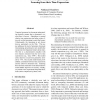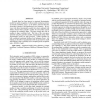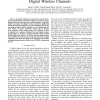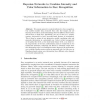ACL
2012
12 years 9 months ago
2012
Temporal reasoners for document understanding typically assume that a document’s creation date is known. Algorithms to ground relative time expressions and order events often re...
106
click to vote
JMLR
2012
12 years 9 months ago
2012
Temporal Clustering (TC) refers to the factorization of multiple time series into a set of non-overlapping segments that belong to k temporal clusters. Existing methods based on e...
ICASSP
2011
IEEE
13 years 11 months ago
2011
IEEE
Recently there has been interest in structured discriminative models for speech recognition. In these models sentence posteriors are directly modelled, given a set of features ext...
IJON
2011
14 years 2 months ago
2011
Restricted Boltzmann Machines (RBM) are well-studied generative models. For image data, however, standard RBMs are suboptimal, since they do not exploit the local nature of image ...
CORR
2010
Springer
14 years 2 months ago
2010
Springer
What does a typical road network look like? Existing generative models tend to focus on one aspect to the exclusion of others. We introduce the general-purpose quadtree model and ...
CVPR
2011
IEEE
14 years 3 months ago
2011
IEEE
We describe a generative model of the relationship between two images. The model is defined as a factored threeway Boltzmann machine, in which hidden variables collaborate to de�...
ICCV
2009
IEEE
14 years 5 months ago
2009
IEEE
Hybrid generative-discriminative techniques and, in particular, generative score-space classification methods have proven to be valuable approaches in tackling difficult object or...
ICC
2009
IEEE
14 years 5 months ago
2009
IEEE
Abstract--Generative models are created to be used in the design and performance assessment of high layer wireless communication protocols and some error control strategies. Genera...
ICB
2009
Springer
14 years 5 months ago
2009
Springer
We present generative models dedicated to face recognition. Our models consider data extracted from color face images and use Bayesian Networks to model relationships between diffe...
PAMI
2002
14 years 7 months ago
2002
The product of experts learning procedure [1] can discover a set of stochastic binary features that constitute a nonlinear generative model of handwritten images of digits. The qua...




